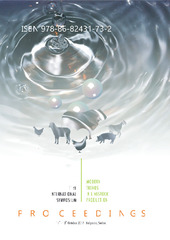Приказ основних података о документу
Cropping system and fertilization regime as factors of maize grain quality
| dc.creator | Dragičević, Vesna | |
| dc.creator | Simic, Milena | |
| dc.creator | Kresovic, Branka | |
| dc.creator | Brankov, Milan | |
| dc.date.accessioned | 2022-07-01T07:52:38Z | |
| dc.date.available | 2022-07-01T07:52:38Z | |
| dc.date.issued | 2017 | |
| dc.identifier.isbn | 978-86-82431-73-2 | |
| dc.identifier.uri | http://rik.mrizp.rs/handle/123456789/983 | |
| dc.description.abstract | Maize cropping systems include continuous cropping (monoculture), which is one of the widespread systems of maize growing in Serbia and in the world, as well as rotations which include rotation of crops of different species, enabling better control of diseases, pests and weeds, as well as better utilization of water and nutrients from soil, having as a consequence increased yields. When leguminous crop is prior to maize in rotations, the maize grain yields are much higher than in rotations when some other crops are prior to maize. The aim of experiment was to evaluate different cropping systems, which include maize monoculture, maize-winter wheat rotation, maize-field pea rotation and maize-field pea-winter wheat rotation (M-P-W) and three fertilization regimes, with increased NPK levels in regard to maize grain yield and grain quality (protein and oil content) during two opposite years in meteorological factors. The significant variations in maize grain yield, protein and oil content were mainly obtained by the influence of growing season, as well as its interaction with cropping system and fertilization regime. Meaning that almost double lower yield, slightly lower oil content and about 1/3 higher protein content were obtained in dry 2015, in relation to 2014, as a season with high precipitation level and lower average temperature. Rotation with higher crop number included (M-P-W rotation) expressed the highest impact on maize yield increase, together with protein and oil content in grain, particularly during stressful 2015. Similar trend was observed in two crop rotation, where legume crop is prior to maize. What is more, increased fertilization level, mainly F3 and in some extent F4 treatment, were positively reflected on increase in yielding potential and protein content, but it decreased oil content in grain. Poorer growth conditions, present in maize monoculture revealed lower grain yield and protein content, with greater oil content, particularly in F1 treatment. This means that increased fertilization was followed significantly by yield and protein increase in grain, but negatively by oil content in grain. | sr |
| dc.language.iso | en | sr |
| dc.publisher | Belgrade : Institute for animal husbandry | sr |
| dc.relation | info:eu-repo/grantAgreement/MESTD/Technological Development (TD or TR)/31037/RS// | sr |
| dc.rights | openAccess | sr |
| dc.rights.uri | https://creativecommons.org/licenses/by/4.0/ | |
| dc.source | 11. International symposium „Modern trends in livestock production“, 11-13.10.2017., Belgrade, Serbia – Book of proceedings | sr |
| dc.subject | fertilization | sr |
| dc.subject | maize grain quality | sr |
| dc.subject | oil content | sr |
| dc.subject | protein content | sr |
| dc.subject | rotation | sr |
| dc.title | Cropping system and fertilization regime as factors of maize grain quality | sr |
| dc.type | conferenceObject | sr |
| dc.rights.license | BY | sr |
| dc.citation.spage | 696 | |
| dc.citation.epage | 705 | |
| dc.identifier.fulltext | http://rik.mrizp.rs/bitstream/id/4782/bitstream_4782.pdf | |
| dc.identifier.rcub | https://hdl.handle.net/21.15107/rcub_rik_983 | |
| dc.type.version | publishedVersion | sr |


